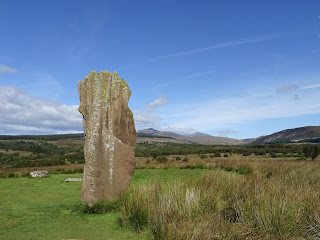Ah, what to do on the day they are
burying a long serving monarch and you don’t really fancy being stuck in the
house all day watching all that pomp and ceremony? Well, taking a lead from a kids’ TV show I
remember from the Seventies ‘Why Don’t You Just
Switch Off Your Television Set and Go and Do Something Less Boring Instead?’ I did just that. I got up off my fat backside and went out for
a walk up in the hills by the village of Moniaive.
Stopping off in Moniaive first of all, I
wandered through the rather picturesque and very quiet village. Everything was shut and no-one was out on the
street, I assume because they were all staying in and watching the funeral. Though, maybe they were all at home busy
writing, composing and painting, as Moniaive is one of these places that despite
its size has attracted many musicians, authors, and artists. The artist James Paterson, one of the ‘Glasgow
Boys’ lived here, as did the author of ‘Black Narcissus’, Rumer Godden, the comic
book writer, Alan Grant, and the musician Alex Kapranos.
In the warm, afternoon sun I walked out
of the village and up a track leading through some woods and then on to a steep,
grassy, and bumpy path lined by two drystane dykes. As I walked up the hill, I could see the sky
around me darkening as the rain clouds came rolling in.
I made it up to the rather atmospheric
ruins of Upper Bardennoch Farm where I had a staring competition with a ram who
after sizing me up for a bit, wandered off and kept a wary eye on me from a
safe distance. Then the rain came down. It poured and poured and soaked right through
the cheap and nasty ‘waterproof’ jacket I was wearing. Five minutes later the rain was gone, the sun
was out again, and I was drying off nicely.
I had a wander around the ruins of the
farm, which I suppose at some time in the not too distant past had been a home
and a livelihood for someone but was now abandoned and falling down. Parts of the farmhouse roof had caved in, and
the doors and windows had been removed and replaced with iron bars to keep the
curious out. The remains of the
outbuildings now served as nothing more than a place for sheep to shelter from
the elements, with the ground in them a sludge of sheep poo and the walls a scraped
fluff with tufts of wool.
I left a Skulferatu in one of the many
cracks in the farmhouse walls and then I carried on with my walk to the top of Bardennoch
Hill, before making my way back to Moniaive.
The coordinates for the location of the
Skulferatu are –
Latitude 55.206379
Longitude -3.91858
what3words: records.puppy.pocketed




































